Numerical Simulation and Environmental Impact Assessment of VOCs Diffusion Based on Multi-Emission Sources in the Natural Gas Purification Plant
Abstract
:1. Introduction
2. Materials and Methods
2.1. Governing Equations and Turbulence Models
2.1.1. Fundamental governing equation
2.1.2. Turbulence Equation
2.2. Model and Boundary Conditions
2.3. Grid Independence Verification
2.4. Accuracy Verification of Numerical Simulation
3. Results and Discussion
3.1. Analysis of Pressure Field and Flow Field
3.1.1. Pressure Field Analysis
3.1.2. Flow Field Analysis
3.2. Environmental Impact Assessment
4. Conclusions
- (1)
- Combining numerical simulation with on-site data offers clear insights into the oil vapor diffusion process. Understanding parameters such as diffusion range, rate, and concentration aids in identifying hazardous zones and implementing effective emergency response measures, thereby minimizing environmental damage and accident losses. The findings are valuable for managing oil vapor emissions in the petroleum industry and have practical implications for leakage prevention and mitigation.
- (2)
- Wind speed significantly influences the natural gas purification plant, creating pressure differentials and areas of high oil vapor concentration. Eddy currents and backflow generate negative pressure zones between storage tanks and on the leeward side of leakage sources. The high-concentration area of oil vapor accumulation at v = 4 m·s−1 is eight times that at v = 8 m·s−1. Decreased wind speed exacerbates vapor accumulation, increasing the risk of explosions.
- (3)
- Obstacles around the leakage source complicate vapor diffusion. Encountering obstacles like tanks and pools results in the formation of high-concentration hazardous areas. Reduced airflow velocity and vortex phenomena on the leeward side hinder dispersion, raising the risk of reaching explosive limits. Constructing enclosed buildings near the source can effectively impede vapor dispersion and prevent leaks.
- (4)
- Based on real-time field surveys, the simulation conditions in this study represent the overall VOC dispersion scenario at the natural gas station under most circumstances. However, further investigation and research are needed for extreme weather conditions.
Author Contributions
Funding
Data Availability Statement
Acknowledgments
Conflicts of Interest
References
- Onel, O.; Niziolek, A.M.; Floudas, C.A. Optimal Production of Light Olefins from Natural Gas via the Methanol Intermediate. Ind. Eng. Chem. Res. 2016, 55, 3043–3063. [Google Scholar] [CrossRef]
- Zheng, Y.H.; Luo, D.K. Industrial structure and oil consumption growth path of China: Empirical evidence. Energy 2013, 57, 336–343. [Google Scholar] [CrossRef]
- Khanjar, J.M.; Amiri, E.O. Simulation and parametric analysis of natural gas sweetening process: A case study of Missan Oil Field in Iraq. Oil Gas Sci. Technol. Rev. D IFP Energ. Nouv. 2021, 76, 53. [Google Scholar] [CrossRef]
- An, Q.E.; Zhu, M.; Qu, D.B.; Zhang, H. Embodied crude oil analysis of Chinese economy from 2011 to 2014. Innov. Solut. Energy Transit. 2019, 158, 3553–3558. [Google Scholar] [CrossRef]
- Zhou, M.; Jiang, X.; Zhai, L.; Jin, X.; An, H.; Ding, Z.; Shen, F. Simulation of the Internal Temperature Field and Flow Field in a Double-Layer Sintering Bed. ACS OMEGA 2022, 7, 46777–46786. [Google Scholar] [CrossRef] [PubMed]
- Zhang, P.; Chen, X.; Fan, C. Research on a safety assessment method for leakage in a heavy oil gathering pipeline. Energies 2020, 13, 1340. [Google Scholar] [CrossRef]
- Yang, M.; Khan, F.; Lye, L.; Amyotte, P.R. Risk assessment of rare events. Process Safety and Environmental Protection. Water Res. 2015, 98, 102–108. [Google Scholar] [CrossRef]
- Atkinson, G.; Cowpe, E.; Halliday, J.; Painter, D. A review of very large vapor cloud explosions: Cloud formation and explosion severity. J. Loss Prev. Process Ind. 2017, 48, 367–375. [Google Scholar] [CrossRef]
- Milazzo, M.F.; Ancione, G.; Lisi, R. Emissions of volatile organic compounds during the ship-loading of petroleum products: Dispersion modelling and environmental concerns. J. Environ. Manag. 2017, 204, 637–650. [Google Scholar] [CrossRef]
- Cirimello, P.G.; Otegui, J.L.; Ramajo, D.; Carfi, G. A major leak in a crude oil tank: Predictable and unexpected root causes. Eng. Fail. Anal. 2019, 100, 456–469. [Google Scholar] [CrossRef]
- Chen, K.; Khan, F.; Jing, X.F. Safety assessment of natural gas purification plant. Process Saf. Environ. Prot. 2018, 113, 459–466. [Google Scholar] [CrossRef]
- Zhang, M. Simulation and risk assessment of methanol tank leakage accidents. Guangdong Chem. Ind. 2014, 41, 259–260. [Google Scholar] [CrossRef]
- Liu, L.; Meng, B.; Wang, Q. Study on influence of cofferdam on leakage and diffusion law of LNG storage tank. New Technol. New Technol. 2014, 12, 115–118. [Google Scholar] [CrossRef]
- Liang, X.M.; Sun, X.B.; Xu, J.T.; Ye, D.Q.; Chen, L.G. Industrial Volatile Organic Compounds (VOCs) Emission Inventory in China. Environ. Sci. 2020, 41, 4767–4775. [Google Scholar] [CrossRef]
- Li, X.; Li, B.; Guo, L.; Feng, R.; Fang, X. Research progresses on VOCs emission investigations via surface and satellite observations in China. Environ. Sci. -Process. Impacts 2022, 24, 1968–1981. [Google Scholar] [CrossRef] [PubMed]
- Simayi, M.; Shi, Y.; Xi, Z.; Ren, J.; Hini, G.; Xie, S. Emission trends of industrial VOCs in China since the clean air action and future reduction perspectives. Sci. Total Environ. 2022, 826, 153994. [Google Scholar] [CrossRef]
- Wu, T.; Cui, Y.; Lian, A.; Tian, Y.; Li, R.; Liu, X.; Yan, J.; Xue, Y.; Liu, H.; Wu, B. Vehicle emissions of primary air pollutants from 2009 to 2019 and projection for the 14th Five-Year Plan period in Beijing, China. J. Environ. Sci. 2023, 124, 513–521. [Google Scholar] [CrossRef] [PubMed]
- Zheng, H.; Kong, S.; Xing, X.; Mao, Y.; Hu, T.; Ding, Y.; Li, G.; Liu, D.; Li, S.; Qi, S. Monitoring of volatile organic compounds (VOCs) from an oil and gas station in northwest China for 1 year. Atmos. Chem. Phys. 2018, 18, 4567–4595. [Google Scholar] [CrossRef]
- Goeury, C.; Hervouet, J.M.; Baudin-Bizien, I.; Thouvenel, F. A Lagrangian/Eulerian oil spill model for continental waters. J. Hydraul. Res. 2014, 52, 36–48. [Google Scholar] [CrossRef]
- Huang, W.; Huang, F.; Fang, J.; Fu, L. A calculation method for the numerical simulation of oil products evaporation and vapor diffusion in an internal floating-roof tank under the unsteady operating state. J. Pet. Sci. Eng. 2020, 188, 106867. [Google Scholar] [CrossRef]
- Zhang, T.; Li, G.; Yu, Y.; Ji, Y.; An, T. Atmospheric diffusion profiles and health risks of typical VOC: Numerical modelling study. J. Clean. Prod. 2020, 275, 122982. [Google Scholar] [CrossRef]
- Bellegoni, M.; Ovidi, F.; Landucci, G.; Tognotti, L.; Galletti, C. CFD analysis of the influence of a perimeter wall on the natural gas dispersion from an LNG pool. Process Saf. Environ. Prot. 2021, 148, 751–764. [Google Scholar] [CrossRef]
- Zhang, G.; Huang, F.; Huang, W.; Zhu, Z.; Fang, J.; Ji, H.; Fu, L.; Sun, X. Analysis of Influence of Floating-Deck Height on Oil-Vapor Migration and Emission of Internal Floating-Roof Tank Based on Numerical Simulation and Wind-Tunnel Experiment. Processes 2020, 8, 1026. [Google Scholar] [CrossRef]
- Ge, Y.Q.; Huang, W.Q.; Li, X.F.; Yao, J.; Yang, Q.; Zhang, C.; Kong, X.Y.; Zhou, N. Numerical investigation on oil leakage and migration from the accidental hole of tank wall in oil terminal of pipeline transportation system. J. Pipeline Sci. Eng. 2024, 100175. [Google Scholar] [CrossRef]
- Fujii, K. Progress and future prospects of CFD in aerospace—Wind tunnel and beyond. Prog. Aerosp. Sci. 2005, 41, 455–470. [Google Scholar] [CrossRef]
- Lapuerta, M.; Hernández, J.P.; Agudelo, J.R. An equation for the estimation of alcohol-air diffusion coefficients for modelling evaporation losses in fuel systems. Appl. Therm. Eng. 2015, 73, 539–548. [Google Scholar] [CrossRef]
- Kountouriotis, A.; Aleiferis, P.G.; Charalambides, A.G. Numerical investigation of VOC levels in the area of petrol stations. Sci. Total Environ. 2014, 470–471, 1205–1224. [Google Scholar] [CrossRef]
- Tominaga, Y.; Stathopoulos, T. CFD simulation of near-field pollutant dispersion in the urban environment: A review of current modeling techniques. Atmos. Environ. 2013, 79, 716–730. [Google Scholar] [CrossRef]
- Fang, J.; Huang, W.; Huang, F.; Fu, L.; Zhang, G. Investigation of the Superposition Effect of Oil Vapor Leakage and Diffusion from External Floating-Roof Tanks Using CFD Numerical Simulations and Wind-Tunnel Experiments. Processes 2020, 8, 299. [Google Scholar] [CrossRef]
- Matthew, J.R. CFD prediction of the trajectory of a liquid jet in a non-uniform air crossflow. Comput. Fluids 2006, 35, 463–476. [Google Scholar] [CrossRef]
- Moen, A.; Mauri, L.; Narasimhamurthy, V.D. Comparison of k-ε models in gaseous release and dispersion simulations using the CFD code FLACS. Process Saf. Environ. Prot. 2019, 130, 306–316. [Google Scholar] [CrossRef]
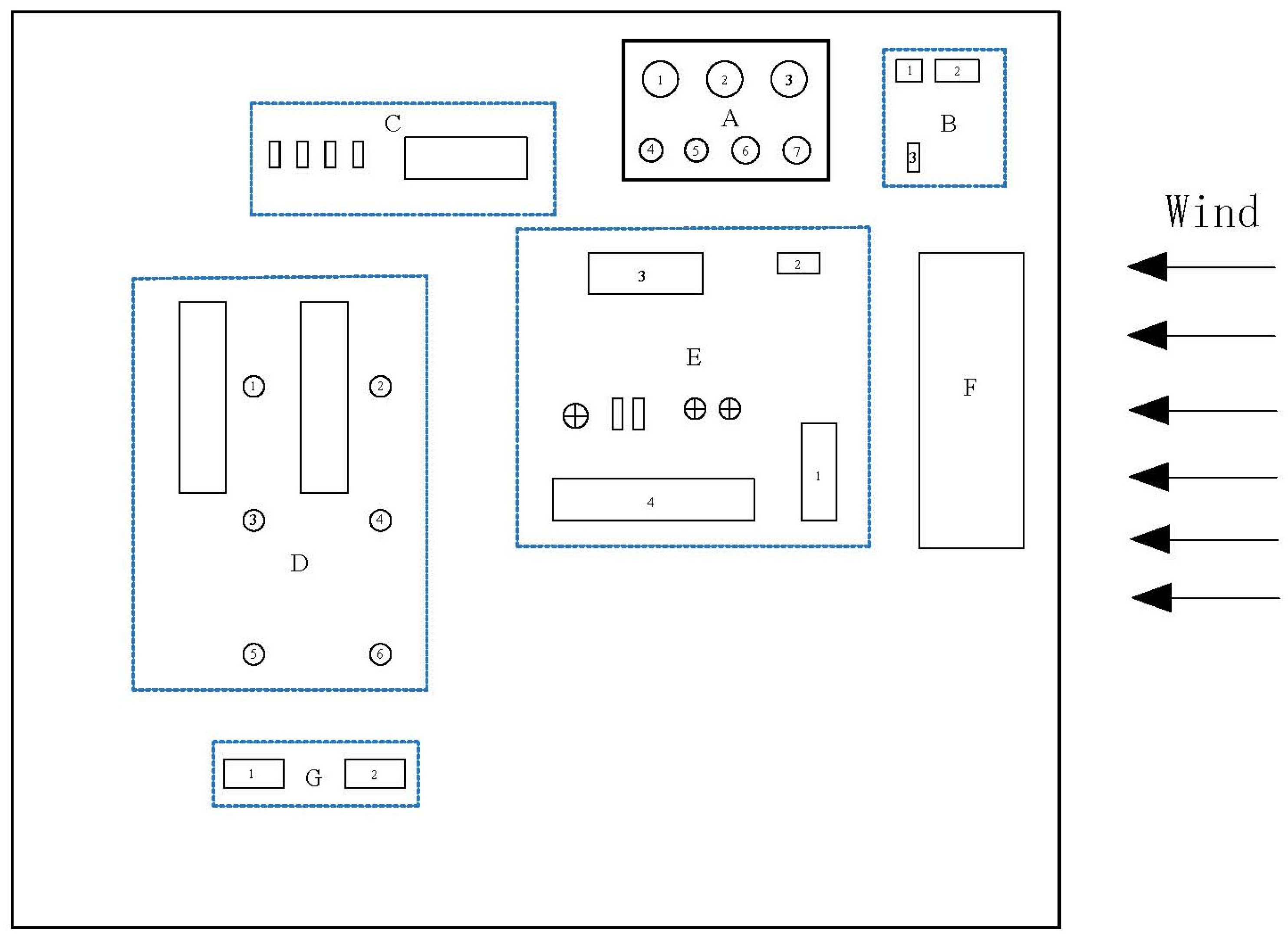


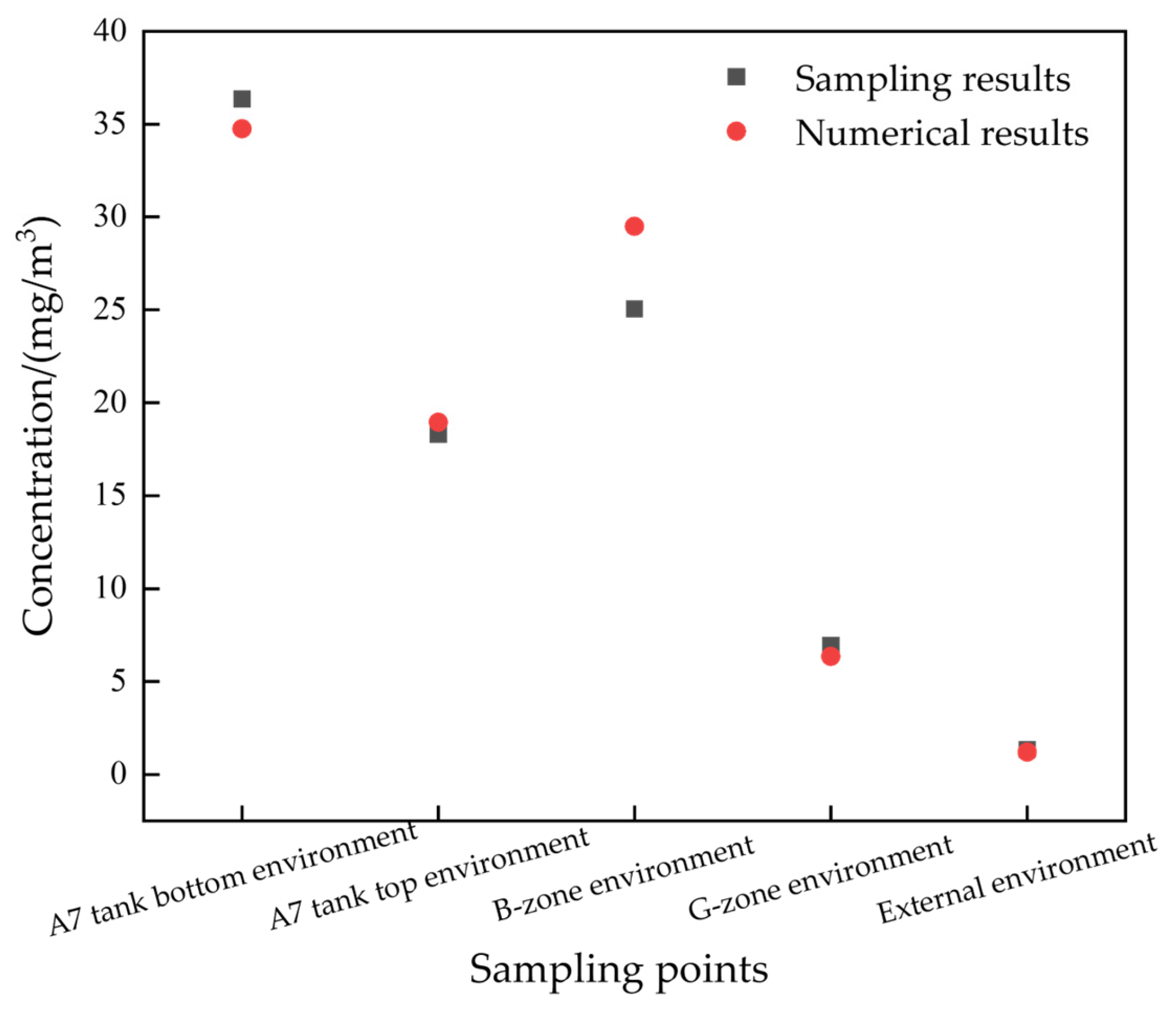
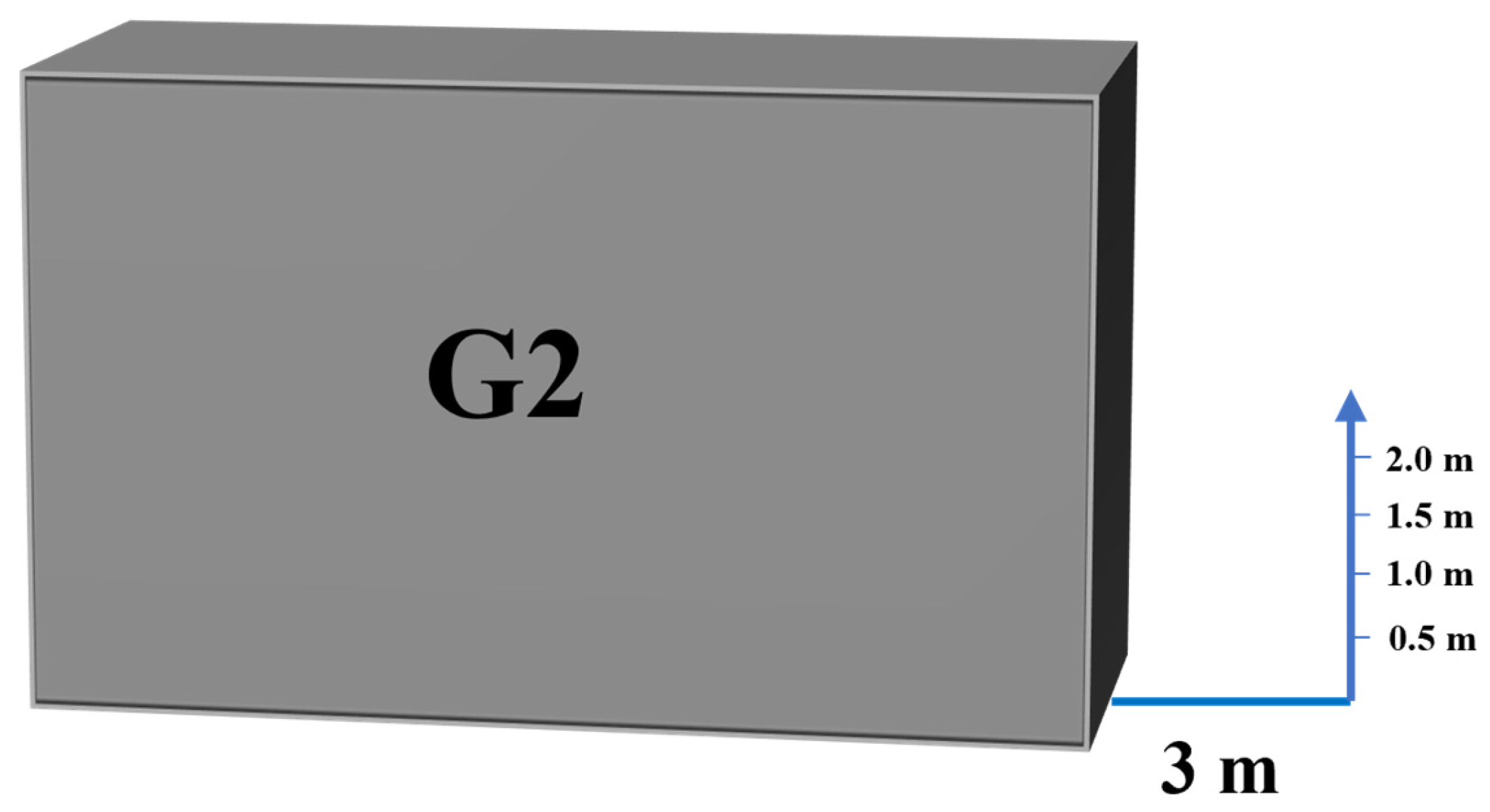
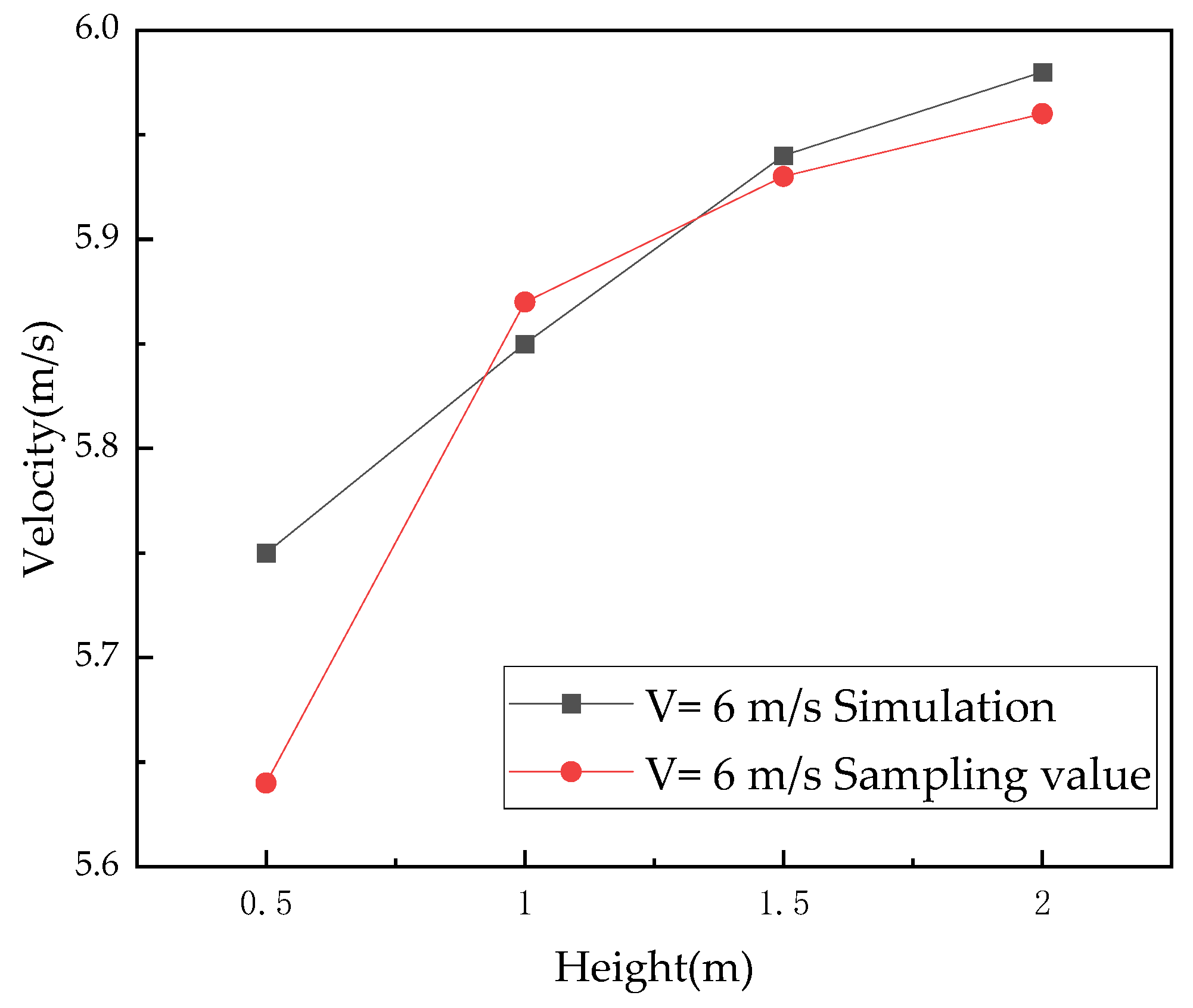

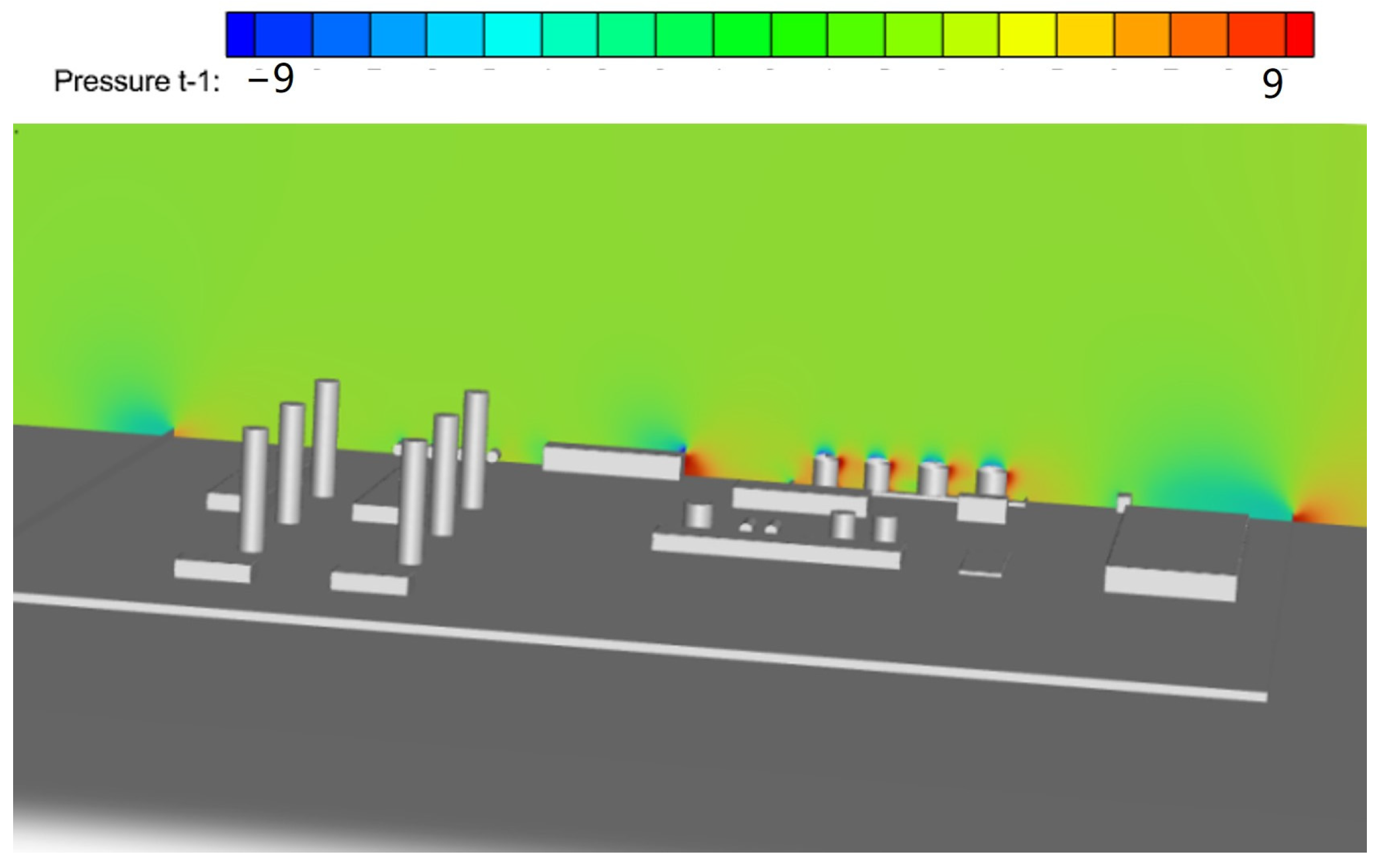
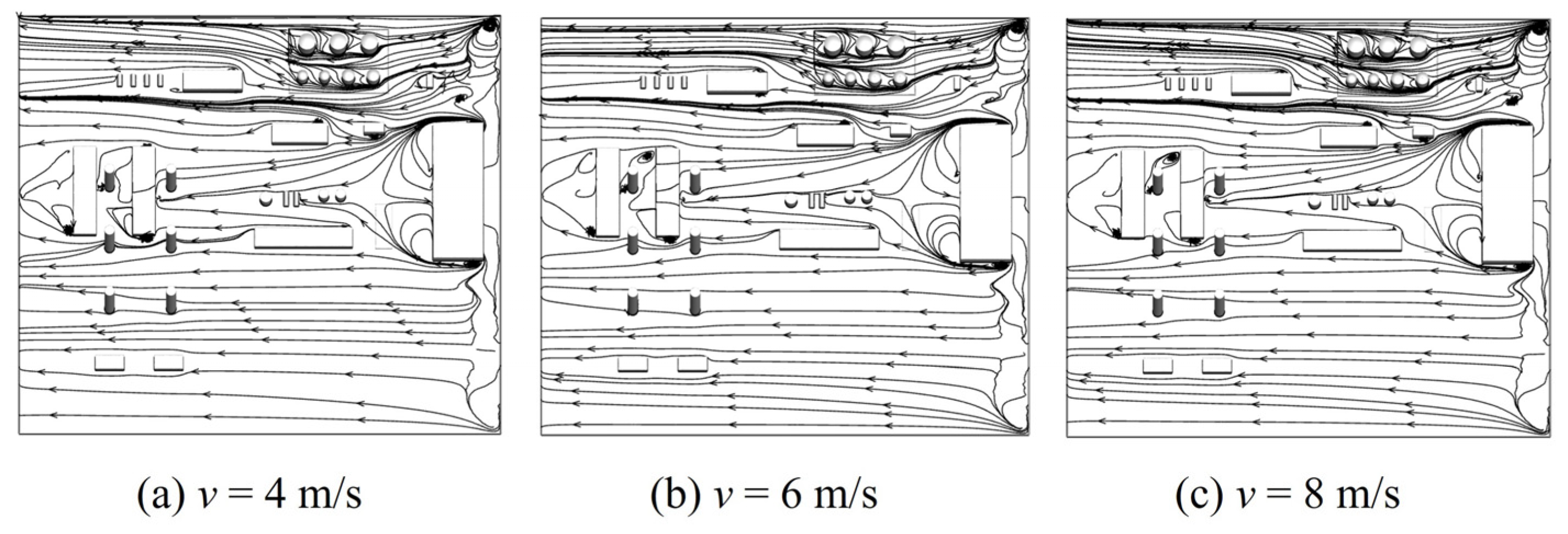
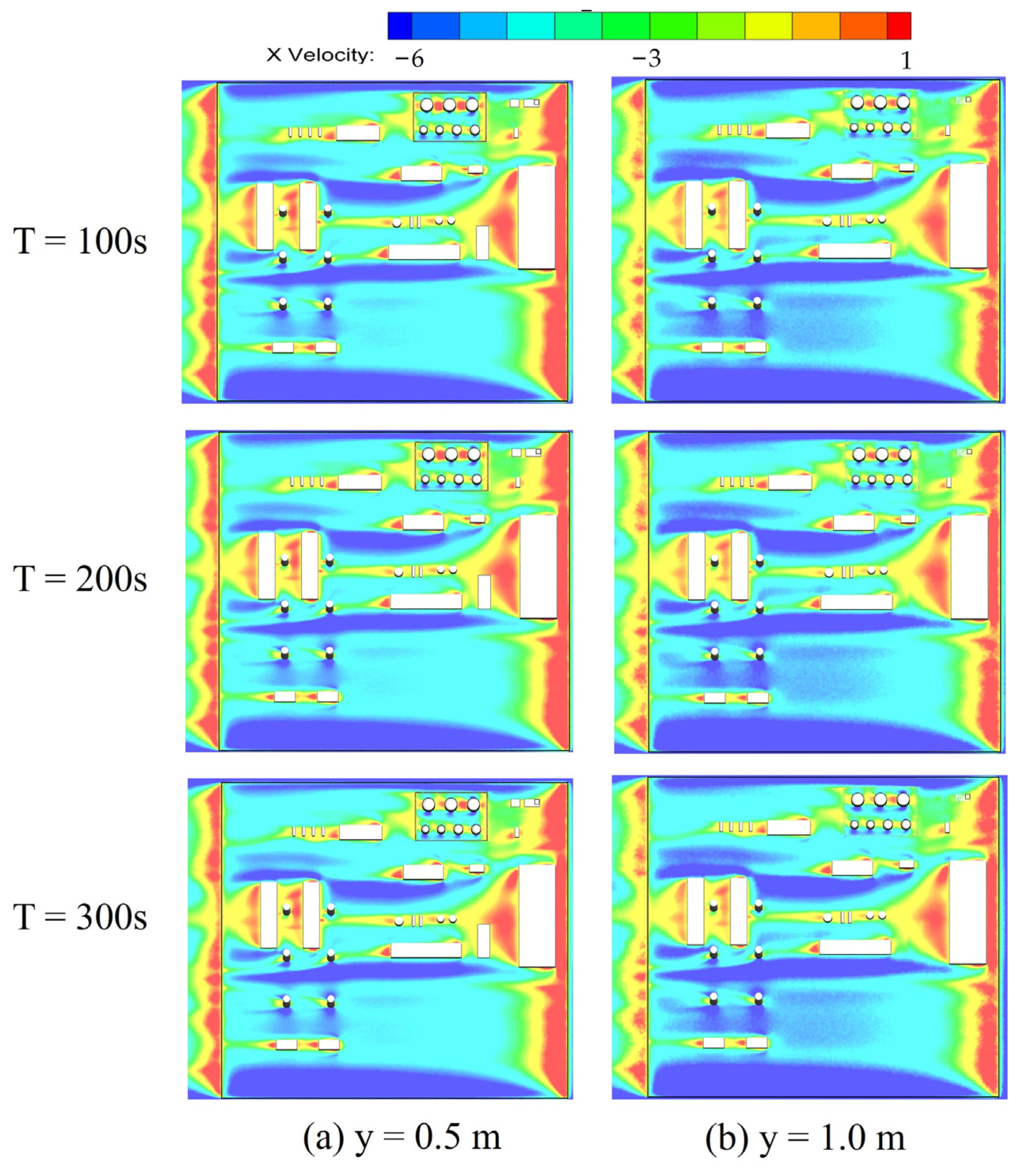

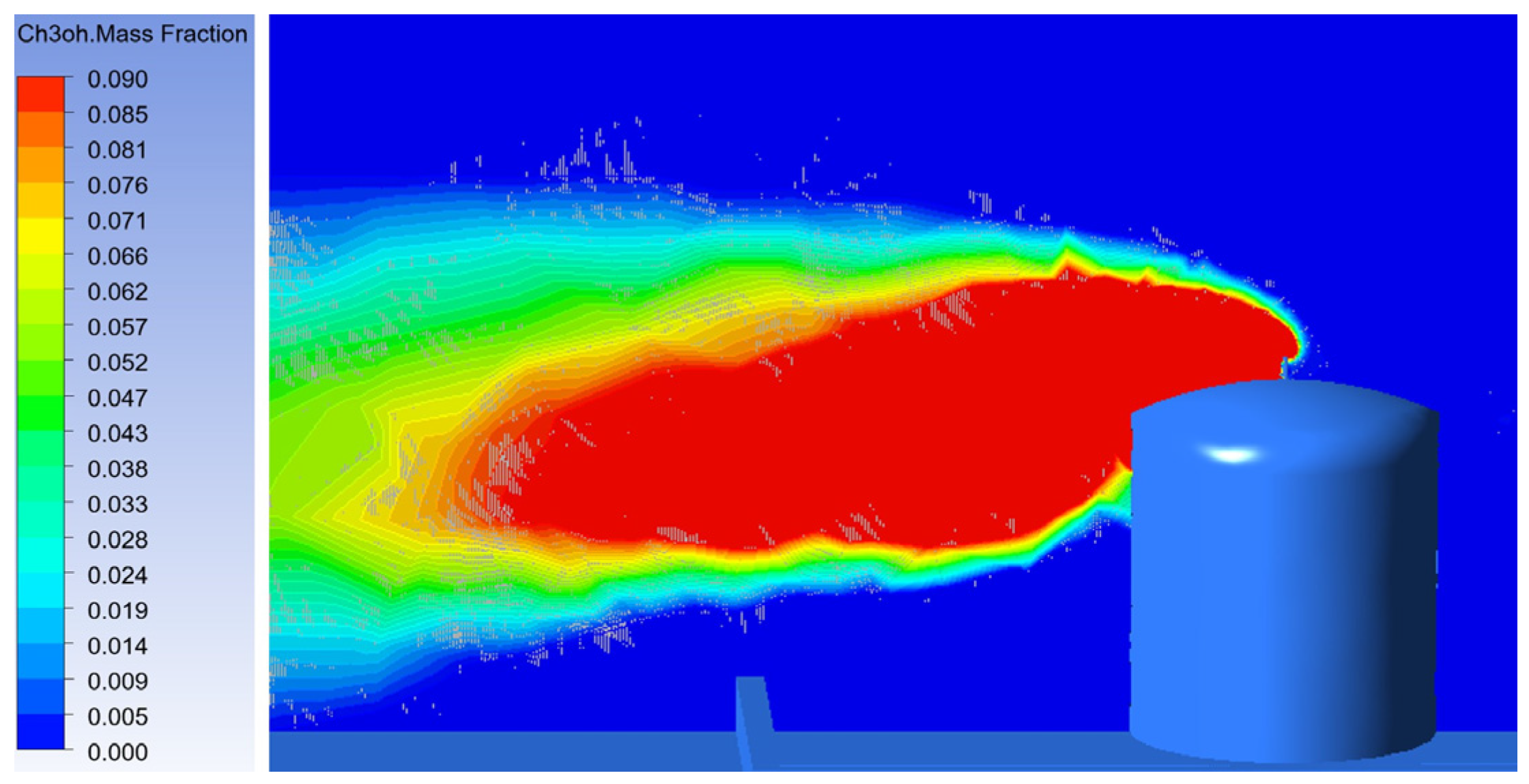
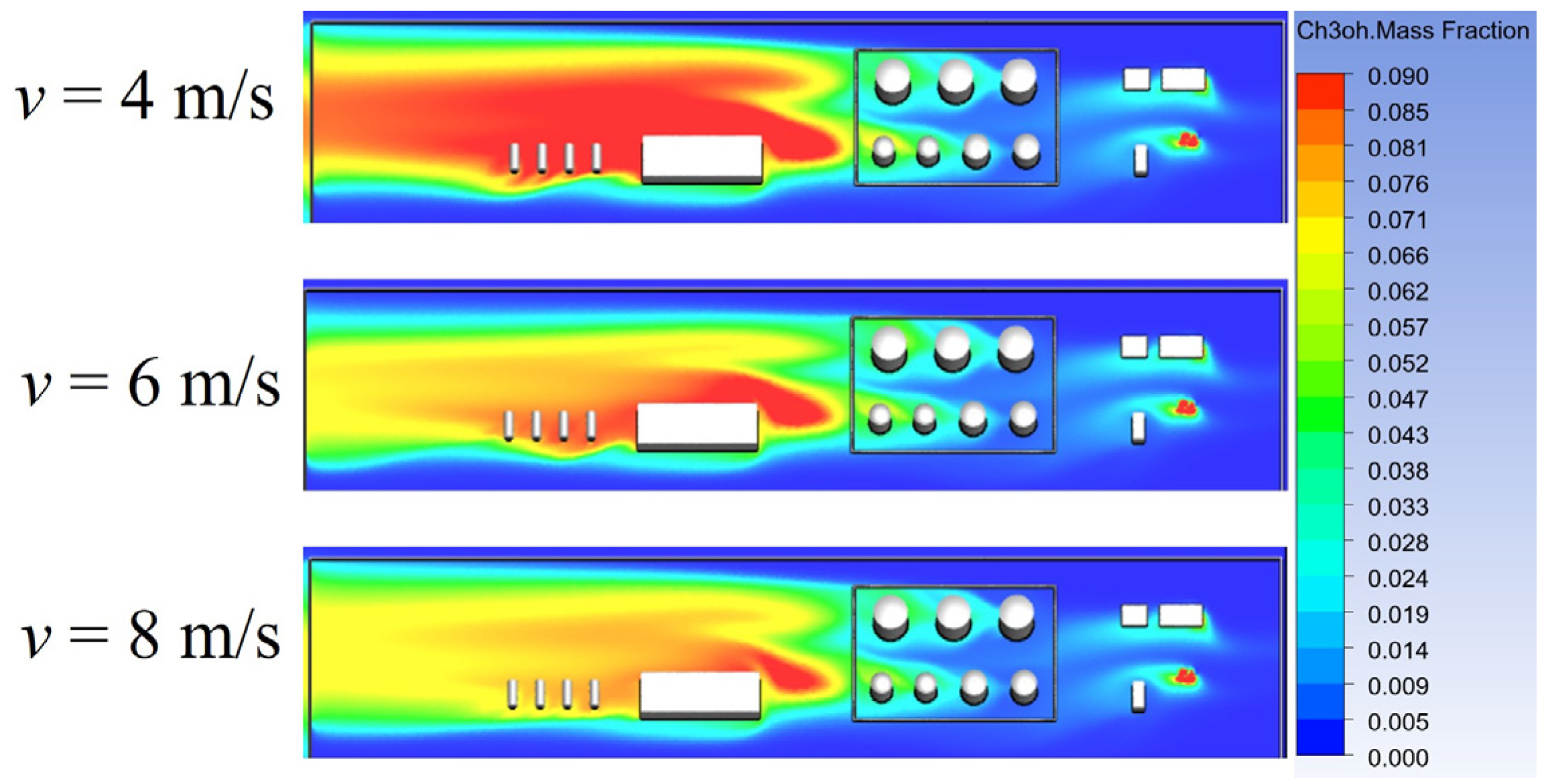

| Equation | The Value of the Generalized Variable Φ | The Value of the Generalized Diffusion Coefficient Γ | Generalized Source Term S |
|---|---|---|---|
| Mass conservation equation | 1 | 0 | 0 |
| Momentum conservation equation | |||
| Energy conservation equation | |||
| Component transport equation |
| Number | A1–A3 | A4, A5 | A6, A7 | D1–D6 |
|---|---|---|---|---|
| Area name | Raw material methanol wastewater tanks | Methanol wastewater receiving tanks | Product methanol tanks | Desulfurization tower |
| Diameter (m) | 10.2 | 6.6 | 7.7 | 6.0 |
| Height (m) | 8.9 | 6.9 | 7.1 | 40.0 |
| Volume (m3) | 700 | 200 | 300 | - |
| Number | B1 | B2 | B3 | E1 | E2 | E3 | E4 | F |
|---|---|---|---|---|---|---|---|---|
| Area name | Cesspit | Drying pool | Drying pool | Cesspit | Sewage installation | Sewage installation | Sewage installation | Nitrogen station |
| Length(m) | 7.45 | 12.5 | 3.4 | 10.0 | 12.0 | 33.0 | 58.0 | 30.0 |
| Width (m) | 6.3 | 6.3 | 8.0 | 28.0 | 8.0 | 12.0 | 12.0 | 85.0 |
| Height (m) | 0.8 | 1.2 | 0.8 | 0.8 | 3.0 | 3.0 | 3.0 | 6.0 |
| Project | Number of Grids | |||
|---|---|---|---|---|
| A/877,650 | B/1,380,025 | C/2,202,403 | D/2,902,573 | |
| Velocity in the X direction (m·s−1) | 5.21 | 5.44 | 5.72 | 5.72 |
| Sampling Point | Sampling Results | Numerical Results |
|---|---|---|
| A7 tank bottom environment | 36.35 | 34.75 |
| A7 tank top environment | 18.3 | 18.95 |
| B-zone environment | 25.05 | 29.5 |
| G-zone environment | 6.95 | 6.35 |
| External environment | 1.35 | 1.2 |
Disclaimer/Publisher’s Note: The statements, opinions and data contained in all publications are solely those of the individual author(s) and contributor(s) and not of MDPI and/or the editor(s). MDPI and/or the editor(s) disclaim responsibility for any injury to people or property resulting from any ideas, methods, instructions or products referred to in the content. |
© 2024 by the authors. Licensee MDPI, Basel, Switzerland. This article is an open access article distributed under the terms and conditions of the Creative Commons Attribution (CC BY) license (https://creativecommons.org/licenses/by/4.0/).
Share and Cite
Ge, Y.; Huang, W.; Li, X.; Xu, Z.; Yang, Q.; Zhang, C.; Zhou, N.; Kong, X.; Tian, X. Numerical Simulation and Environmental Impact Assessment of VOCs Diffusion Based on Multi-Emission Sources in the Natural Gas Purification Plant. Processes 2024, 12, 364. https://doi.org/10.3390/pr12020364
Ge Y, Huang W, Li X, Xu Z, Yang Q, Zhang C, Zhou N, Kong X, Tian X. Numerical Simulation and Environmental Impact Assessment of VOCs Diffusion Based on Multi-Emission Sources in the Natural Gas Purification Plant. Processes. 2024; 12(2):364. https://doi.org/10.3390/pr12020364
Chicago/Turabian StyleGe, Yuqian, Weiqiu Huang, Xufei Li, Ziqiang Xu, Qin Yang, Cheng Zhang, Ning Zhou, Xiangyu Kong, and Xinchen Tian. 2024. "Numerical Simulation and Environmental Impact Assessment of VOCs Diffusion Based on Multi-Emission Sources in the Natural Gas Purification Plant" Processes 12, no. 2: 364. https://doi.org/10.3390/pr12020364





